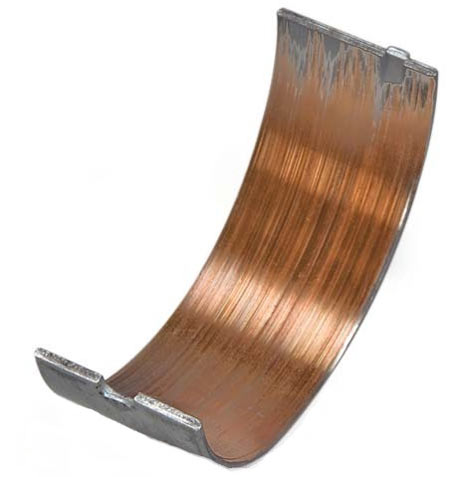Copper materials in bearings
Plain bearings come in a huge range of sizes, and in dealing with engines we will be familiar with a number of different types. The simplest are the cylindrical bush types which we see in various guises, most notably as con rod bushes and valve guides. Con rod bushes and valve guides are most commonly alloys of copper. In the case of the small-end bush, these see relatively little sliding but high loads. The valve guide experiences little load but intermittent sliding.
Copper alloys also find extensive use in some types of 'shell' plain journal bearings, as used for crankshaft main and crankpin bearings and some camshaft bearings. However, in this case, the copper alloy is not intended to come into contact with the rotating component; it is simply an intermediate layer, normally around 0.30-0.38 mm (0.012-0.015 in) thick between the backing and the soft metal alloy (often called white metal or 'Babbitt') that forms the actual bearing surface. This type of bearing construction is known as 'tri-metal' and has been described in previous RET-Monitor articles by John Coxon and Eric Smart.
If we have a strong steel backing and a suitable bearing surface, why do we need an intermediate layer of copper alloy? There are several reasons. The bearing surface itself is made of an overlay material with very low shear strength and high wear rate. It has to be made thin in order to be able to support the forces imposed on it. The copper alloy layer underneath has to be strong enough and stiff enough to support the loads, while being compliant enough to allow sufficient movement and flexibility for the crankshaft. If we were to plate the overlay directly onto a steel backing, any flexibility in the crankshaft would quickly lead to high edge loading and an increase in friction and wear. Another reason for the use of a copper alloy is the slight 'embeddability' it gives the bearing, if the overlay material should fail, by being able to tolerate and capture particles in the oil.

The copper alloy is alloyed with lead and, in some cases, tin. The primary purpose of the lead is to provide a level of lubrication, and the tin is there to provide strength. The lead in the copper alloy also gives some degree of embeddability. Lead-free bearings are widely used in the production car world, and they have been widely discussed in RET-Monitor by Dieter van der Put and Ian Bamsey.
However, a discussion with a leading motorsport bearings supplier revealed that it supplies no bespoke lead-free bearings for race engines. The inherently greater flexibility of race engine crankshafts and camshafts, and their high duty cycle, means the lubricating properties of the intermediate layer are more often called upon. While the lubricity of the copper-lead alloy rose with increasing lead content, the strength falls; lack of fatigue strength of the copper-lead alloy may become a problem when the soft bearing metal has worn away or has fatigued. There is a whole family of copper-lead-tin alloys with differing strength and friction characteristics.
There is a degree of 'comfort' and familiarity with the use of copper-lead alloys in bearings for race engines. There may come a time where lead becomes outlawed for bearings, in which case copper-bismuth alloys are one likely replacement.
Fig. 1 - Sometimes we see more of the copper alloys in tri-metal bearings than we would like
Written by Wayne Ward